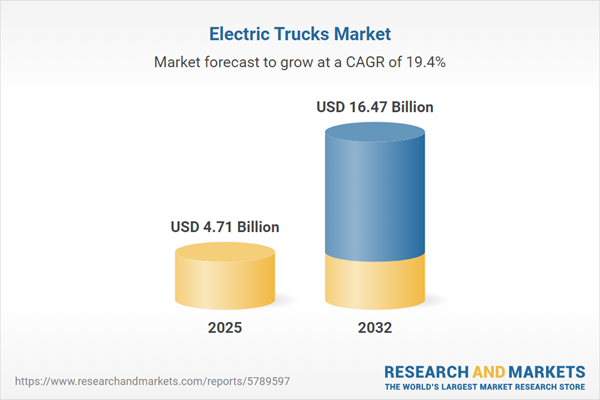Speak directly to the analyst to clarify any post sales queries you may have.
The electric truck market is advancing rapidly, driven by sustainability imperatives, fleet modernization, and regulatory pressures. As electrification transforms commercial transportation, decision-makers must navigate evolving policy landscapes, supply chains, and innovative technologies to maintain leadership in a competitive environment.
Electric Trucks Market Snapshot
The Electric Trucks Market grew from USD 3.97 billion in 2024 to USD 4.71 billion in 2025 and is projected to achieve a Compound Annual Growth Rate (CAGR) of 19.43%, reaching a valuation of USD 16.47 billion by 2032. This growth is fueled by stringent emissions mandates, sustained investment in charging infrastructure, and the proven cost efficiency gains realized by leading fleets. As decarbonization targets accelerate adoption, industry leaders are scaling pilot programs to commercial deployment, shaping new benchmarks for operational performance and reliability across logistics, construction, and municipal applications.
Scope & Segmentation
This report delivers in-depth analysis across all market sub-segments and geographic regions, offering a comprehensive perspective on opportunity and risk for senior stakeholders.
- Payload Capacity: Heavy-duty, medium-duty, and light-duty electric trucks, reflecting varied operational requirements from long-haul to urban delivery fleets.
- Trucks Type: Box trucks, dump trucks, flatbed trucks, pickup trucks, refrigerated trucks, utility trucks, and waste collection vehicles, each with unique electrification challenges and performance drivers.
- Propulsion Type: Battery electric vehicles, fuel cell electric vehicles, and plug-in hybrid electric vehicles, supporting diverse fleet use cases and infrastructure realities.
- Battery Capacity: Ranges including under 100 kWh, 100–300 kWh, 301–500 kWh, and above 500 kWh, aligned to route length, payload, and operational intensity.
- Application: Agriculture and forestry, construction and mining, logistics and delivery, municipal services (covering both utility repair and waste collection), ports and warehousing, and retail and distribution.
- Sales Channel: Aftermarket retrofit opportunities and OEM-backed solutions, each with implications for procurement, service, and support.
- Regional Coverage: Includes Americas (with North America and Latin America’s key markets), Europe, Middle East & Africa, and Asia-Pacific, capturing localized policies, infrastructure evolution, and manufacturer footprints.
Key Takeaways for Senior Decision-Makers
- The regulatory landscape is rapidly changing, with major incentives and tightening emissions standards influencing both technology adoption and fleet investment cycles.
- Strategic partnerships are critical across OEMs, battery producers, infrastructure companies, and utilities—collaborative models enhance grid integration and enable new service models such as fleet analytics and battery management.
- Innovation in battery architecture and modular vehicle platforms allows greater production scalability and efficient adaptation to shifting regional demand.
- Advanced telematics, predictive maintenance, and route optimization technologies are creating operational value by reducing downtime and maximizing energy efficiency.
- Business models are evolving toward battery-as-a-service and fleet-sharing platforms, helping fleets manage capital outlay and residual asset value.
Tariff Impact on Supply Chains and Competitive Positioning
The introduction of United States tariffs on imported electric trucks and critical battery components in 2025 is affecting supply chain strategies and cost structures. Manufacturers are accelerating efforts to establish local production and deepen supply partnerships, while fleet operators weigh incentive thresholds against payback timelines. Tariff frameworks are also driving joint ventures, reshoring initiatives, and technology transfer agreements that strengthen domestic capacity and mitigate supply risks.
Methodology & Data Sources
The report applies a robust methodology by integrating in-depth primary interviews with senior executives from OEMs, suppliers, fleets, and regulators, complemented by secondary data from technical research, white papers, and corporate disclosures. Proprietary analytical frameworks validate trends in technology readiness, total cost of ownership, and commercial adoption.
Why This Report Matters
- Enables executive teams to benchmark market opportunities and risks in the fast-evolving electric truck sector.
- Supports data-driven decision-making by mapping policy trends, supplier strategies, and customer adoption scenarios in detail.
- Facilitates strategic planning by detailing segmentation dynamics, value chain shifts, and actionable growth imperatives.
Conclusion
As the electric trucks market matures, companies that embrace innovation, agile supply chain management, and cross-sector collaboration are set to lead. This report empowers decision-makers to formulate strategies grounded in comprehensive market intelligence and real-world insight.
Additional Product Information:
- Purchase of this report includes 1 year online access with quarterly updates.
- This report can be updated on request. Please contact our Customer Experience team using the Ask a Question widget on our website.
Table of Contents
3. Executive Summary
4. Market Overview
7. Cumulative Impact of Artificial Intelligence 2025
Companies Mentioned
The companies profiled in this Electric Trucks market report include:- AB Volvo
- BYD Company Limited
- Hyzon Motors Inc.
- Nikola Corporation
- Rivian Automotive, Inc.
- Tesla, Inc.
- Freightliner Trucks by Daimler AG
- PACCAR Inc.
- TRATON SE by Volkswagen Group
- Iveco S.p.A.
- Ford Motor Company
- General Motors Company
- Stellantis N.V.
- Hyundai Motor Company
- Workhorse Group Inc.
- Volta Trucks AB
- Lion Electric Company
- GreenPower Motor Company Inc.
- Tata Motors Limited
- Eicher Motors Limited
- Piaggio Vehicles Pvt. Ltd.
- Ashok Leyland Limited
- Bollinger Motors, Inc.
Table Information
| Report Attribute | Details |
|---|---|
| No. of Pages | 182 |
| Published | November 2025 |
| Forecast Period | 2025 - 2032 |
| Estimated Market Value ( USD | $ 4.71 Billion |
| Forecasted Market Value ( USD | $ 16.47 Billion |
| Compound Annual Growth Rate | 19.4% |
| Regions Covered | Global |
| No. of Companies Mentioned | 24 |









